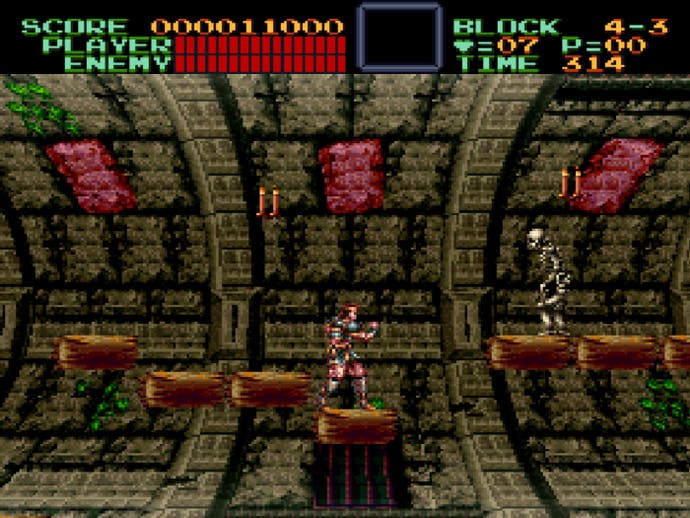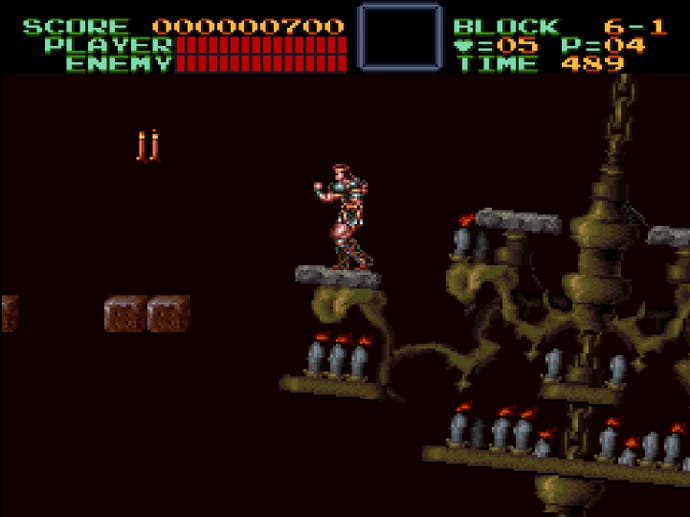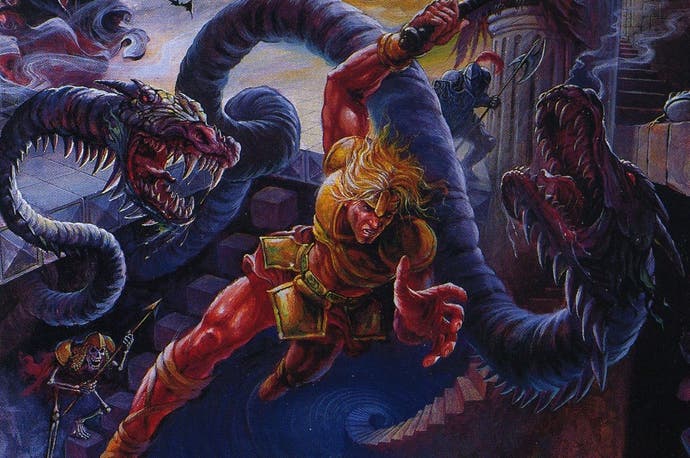Super Castlevania 4 proved the best Dracula games don't have to be scary
Fangs for the memories.
When you stop and think about it, it's perhaps a little unusual that Konami's Castlevania - a series primarily concerned with bloodsucking vampires, crumbling gothic fortresses and ghoulish things that go bump in the night - isn't actually that scary at all. There's nothing to compare to the likes of Resident Evil, Silent Hill or Dead Space, no moments where you jump out of your skin or your find yourself fearful of what lies around the next corner. What Castlevania does have in spades is atmosphere; its finest instalments are fondly recalled because in each one the experience as a whole seems to pull together to create a striking impact on the player. There's no finer example of this quality than Super Castlevania 4.
Released during the Super Nintendo's formative years and following on from three well-received outings on the 8-bit NES, Super Castlevania 4 - or "Devil's Castle Dracula" as it is known in its native Japan - is effectively a retelling of the 1986 original. You once again assume the role of vampire hunter extraordinaire Simon Belmont, a hero who dresses like Conan the Barbarian and utilises an enchanted whip which is deadly to blood suckers, as well as countless other denizens of the night. While the premise may have remained the same, the development team at Konami - led by Masahiro Ueno, the man who helped port Metal Gear from the MSX2 to the NES in three months - was liberated from the restrictions of Nintendo's ageing 8-bit hardware and consequently allowed to run riot on an entirely new console.

One of Konami's earliest ventures on the SNES, Castlevania 4 not only provides a riveting gaming experience, but also a compelling showcase of the console's power. Few lucky enough to experience it at the time of release will be able to forget the impact of the technically stunning fourth stage, which features so many Mode 7 visual effects that it could practically be a Nintendo-sanctioned tech demo. The rotating room sequence was jaw-dropping at the time, as was the smoothly-scaling boss which is found at the climax of the stage. Perhaps most impressive of all is the spinning tunnel section which appears to rotate convincingly around the player (Konami would later use a similar visual trick to add perspective to the vertically-scrolling sections in its SNES shooter Axelay). While some of these effects are mere window dressing, Ueno's team was better than most when it came to harnessing the unique power of the SNES to create situations which simply couldn't be replicated on rival hardware.
It speaks volumes about the overall quality of the game that these technical high-points don't overpower the presentation. Castlevania 4 isn't the most colourful piece of software ever written - compared to other SNES titles at the time, it could even be referred to as somewhat dour - but by resisting the temptation to flood the screen with bright, cartoon-like hues (something which would occur in the next SNES outing, Castlevania: Dracula X, known as Castlevania: Vampire's Kiss in Europe), the game's designers succeeded in crafting a world that appeared to be more realistic than fans of the basic and often gaudy 8-bit versions were accustomed to.
The Transylvanian countryside is packed with greens, browns and greys, while Vlad's slowly decaying citadel possesses only fleeting flashes of colour; a torn tapestry there, a faded glass window there. Those moments where colours are permitted to shine through - such as the trawl through Dracula's gold and jewel-filled treasury in stage nine - are rendered all the more effective by the relative restraint shown elsewhere.

Castlevania 4 added spectacle, and it added control too. The NES entries possess notoriously stiff protagonists and various issues - such as only being able to whip horizontally and not being able to influence your character's direction mid-jump - present a unique set of challenges which can only be overcome with skill, diligence and (possibly most importantly) the patience of a particularly charitable Saint.
By adding eight-way whipping - as well as the famous "whip tickle" - Ueno and his team dramatically increased the player's selection of moves, therefore making it easier to extract oneself from some of the game's more taxing situations. Simon Belmont's direction can be changed mid-air, and he's able to crouch. More dynamically, he's able to use his whip to swing across gaping holes in the scenery - a delightful mechanic which would be revived for the Lords of Shadow sub-series in 2010. The vampire hunter's updated moves have a considerable impact on the way Castlevania 4 plays and feels, and were developed by Mitsuru "Yaiman" Yaida, who - along with several other Konami staffers - would go on to establish Treasure, the studio behind such classics as Gunstar Heroes, Radiant Silvergun and Ikaruga.
Castlevania 4's revised controls make the game more accessible to newcomers than any of its predecessors. As a result, though, some fans consider the fourth Castlevania adventure to be a somewhat watered-down offering, despite the fact that it still poses a considerable challenge to even the most ardent player. It's interesting to note that never again would Konami bless a Belmont with such a wide repertoire of moves; Dracula X: Rondo of Blood on the PC Engine and Castlevania: Bloodlines (AKA: The New Generation) on the Mega Drive - released in 1993 and 1994 respectively - would return to the time-honoured horizontal whipping mechanic, and it has remained largely that way in every 2D Castlevania title released since.

At the time of Castlevania 4, Konami forbade its staff from being credited using their real names out of fear that its most talented workers would be poached by rival firms. And so Castlevania 4's composers Masanori Adachi and Taro Kudo were instead listed as Masanori Oodachi and Souji Taro. Director Ueno - who himself would be credited as Jun Furano - has since stated that he is especially proud of the work achieved by Adachi and Kudo; the music is pivotal in creating some of the game's most atmospheric moments, and more so than ever before in the Castlevania series the audio compliments - and in many cases, dominates - the overall experience. Even when taken out of the context, the compositions remain complex and thrilling to hear; this comfortably ranks as one of the best soundtracks created for any piece of interactive entertainment.
Despite the critical acclaim it received at the time of release, Castlevania 4 did only modest business at retail, reportedly selling just over half a million units worldwide. Konami would take a slightly different stylistic direction with the series from this point onwards, with the aforementioned Rondo of Blood adopting an anime-style aesthetic which eskewed semi-realistic visuals in favour of bright and colourful environments.
The first SNES Castlevania remains unique within the canon of the series, not just due to its graphical approach, but because it delivered many enhancements which would be abandoned in subsequent instalments. Ueno and his team were largely new to the series, and as a result Castlevania 4 feels remarkably unique when compared to other instalments in the franchise. It has a grand scope for a title launched so early in the lifespan of its host hardware, and despite the inexorable passage of time, still has the ability to captivate more than twenty years after its initial release.
Little wonder then that it was one of the first titles earmarked for release on the Wii U Virtual Console, and it's this version - with its player-friendly save states and perfectly upscaled graphics - which perhaps represents the best way to reacquaint yourself with Simon Belmont's thrilling quest to end Dracula's tyranny once and for all. Castlevania would arguably go on to bigger and better things by mixing platforming and RPG mechanics in Symphony of the Night, but its 16-bit debut remains one of the true classics of its age.

